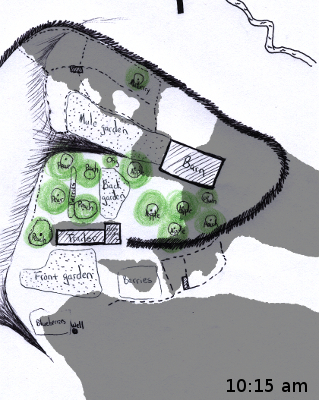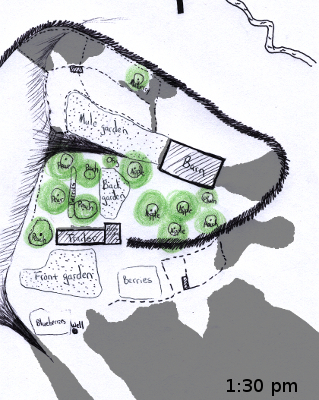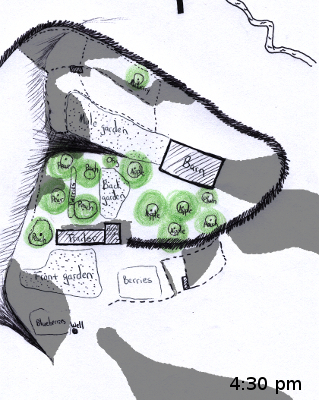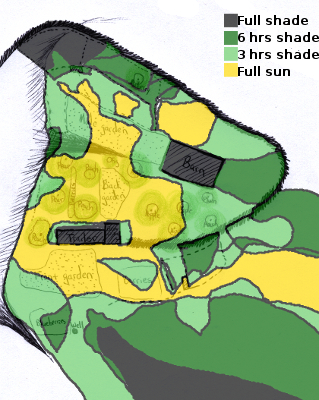
How to map your garden's sun exposure
 They sell fancy gadgets to
map the sun patterns in your yard, but it's not too tough to simply jot
down shade outlines on a map a few times a day. I opted to
measure at 10:15 am, 1:30 pm, and 4:30 pm to get a good overview of the
peak sun hours. (Well, to be honest, I forgot I'd planned to make
a sun map or I would have drafted an earlier morning map as well, and
by supper-time, I wanted to be done with the project.)
They sell fancy gadgets to
map the sun patterns in your yard, but it's not too tough to simply jot
down shade outlines on a map a few times a day. I opted to
measure at 10:15 am, 1:30 pm, and 4:30 pm to get a good overview of the
peak sun hours. (Well, to be honest, I forgot I'd planned to make
a sun map or I would have drafted an earlier morning map as well, and
by supper-time, I wanted to be done with the project.)
My goal was to figure
out which parts of the yard count as full sun, partial sun, or full
shade around the summer solstice. When gardeners talk about full
sun, they mean an area that receives at least 6 hours of direct
sunlight during the peak sun period (when you'd want to be wearing
sunscreen): between about 10 or 11 am and 4 or 5 pm. Partial
shade/partial sun generally refers to 3 to 6 hours of sun, with less of
an emphasis on getting that sun during peak hours. (In fact, some
partial shade plants  might burn to a crisp in
bright afternoon sun.) Full shade generally means that an area
only gets light dappled through trees, perhaps with a couple of hours
of direct sunlight.
might burn to a crisp in
bright afternoon sun.) Full shade generally means that an area
only gets light dappled through trees, perhaps with a couple of hours
of direct sunlight.
When naming the type of
sun in your garden, though, you also have to take your distance from
the equator into account. There's a reason that growers in
equatorial areas came up with the concept of forest
gardening and placed vegetables under their trees --- scorching sun
in Mexico might be so extreme that "full sun" plants would prefer quite
a bit of shade during the early afternoon. On the other hand, if
you live in Alaska, I'm not so sure that an hour of sun around noon
would even count as half an hour of full sun.
Finally, there are more
complex issues to consider. Plants prone to fungal diseases (like
tomatoes) really should get hit with
sun early in the morning to dry off their leaves.  Meanwhile, I'm considering
planting a peach or two in an area with only afternoon sun to slow the
trees down in the spring so their flowers don't get nipped by
frost. And partial shade can be handy for eking spring crops out
in the summer heat, especially if the vegetables are only bearing
leaves. (Leafy vegetables, in general, need less sun than
vegetables who will be asked to produce fruit.)
Meanwhile, I'm considering
planting a peach or two in an area with only afternoon sun to slow the
trees down in the spring so their flowers don't get nipped by
frost. And partial shade can be handy for eking spring crops out
in the summer heat, especially if the vegetables are only bearing
leaves. (Leafy vegetables, in general, need less sun than
vegetables who will be asked to produce fruit.)
If you have a graphics
program that allows layering and transparency (I use the free program
GIMP), it's simple to merge all of your day's maps together and decide
which parts of your yard get what kind of sun. As you can see
from the composite image below, our clearing in the forest gets full
sun only in the very center, with the east end shaded by trees in the
morning and the west end shaded in the afternoon. The powerline
cut provides a bit more  of
a full sun zone, and the spot behind the barn where we recently felled
some trees to dry up the barn wall has a little pocket of full sun as
well.
of
a full sun zone, and the spot behind the barn where we recently felled
some trees to dry up the barn wall has a little pocket of full sun as
well.
Of course, the patterns
change dramatically throughout the year, so I'll make another map at
the winter solstice, if I remember. (Maybe at the equinoxes
too.) I know
from the melting pattern of snow that the sunniest winter areas are quite different from the
sunniest summer areas, with most of the warmth being concentrated in
the mule garden. (There's a big hill on the south side of our
core homestead, so when the sun dips lower in the winter sky, it
doesn't reach the southern parts of the yard much. On the other
hand, leaves are off the trees during the winter, so the forest giants
edging our core area block less light.)
Hopefully getting a
better handle on sun and shade patterns
will help me fill in the gaps in our homestead most efficiently.
Already, I'm eying that area behind the barn for some kind of plant,
and am realizing that the coop for the poor broilers is in the sun all
day long. Aren't maps fun?
Want more in-depth information? Browse through our books.
Or explore more posts by date or by subject.
About us: Anna Hess and Mark Hamilton spent over a decade living self-sufficiently in the mountains of Virginia before moving north to start over from scratch in the foothills of Ohio. They've experimented with permaculture, no-till gardening, trailersteading, home-based microbusinesses and much more, writing about their adventures in both blogs and books.
Want to be notified when new comments are posted on this page? Click on the RSS button after you add a comment to subscribe to the comment feed, or simply check the box beside "email replies to me" while writing your comment.

Mitsy --- I definitely recommend the mapping project. It's lots of fun and helps you notice shade patterns better than you'd see just looking on a map.
I admit to being a bit dubious that Google Earth could figure out our highly complex shade pattern, unless I went to a lot of trouble measuring the height of and adding in the trees encircling our core area. But who knows! I haven't actually played that much with Google Earth.
I have never thought of making a sun exposure map- what a great idea! I will get to work on my own right away. Well, after a few things... Maybe tomorrow..
There is a new Android app which makes sun mapping really easy. Called "Sun And Shade Analyzer" (search Google play store), you can go to any place of interest, scan the surrounding with your Android device, and immediately the app will tell you the average hours of daily sunlight that place will get. The computed average takes into consideration the sun's daily and seasonal motion across the sky, as well as the shade cast by objects such as trees and buildings. https://hookmountain.com